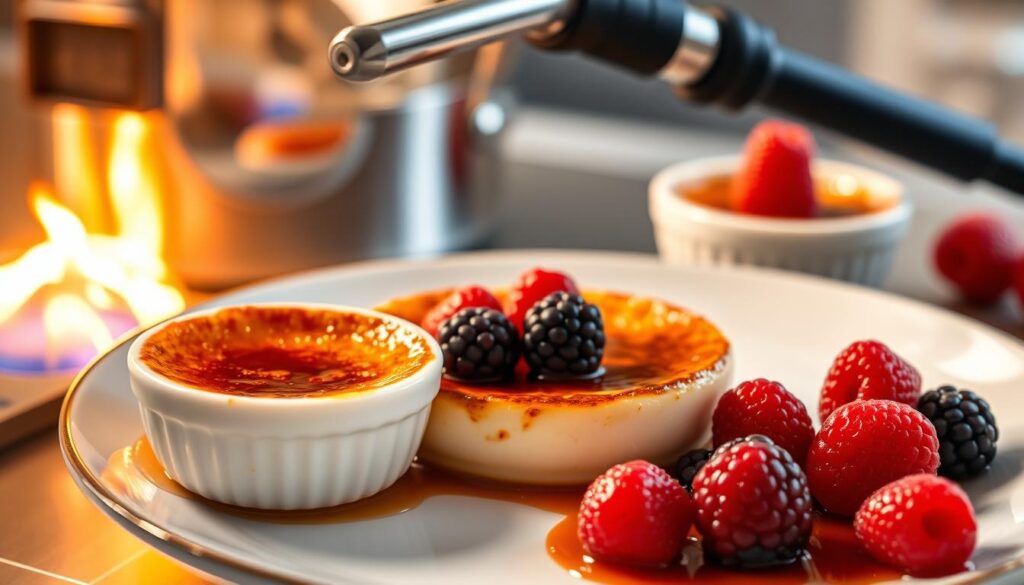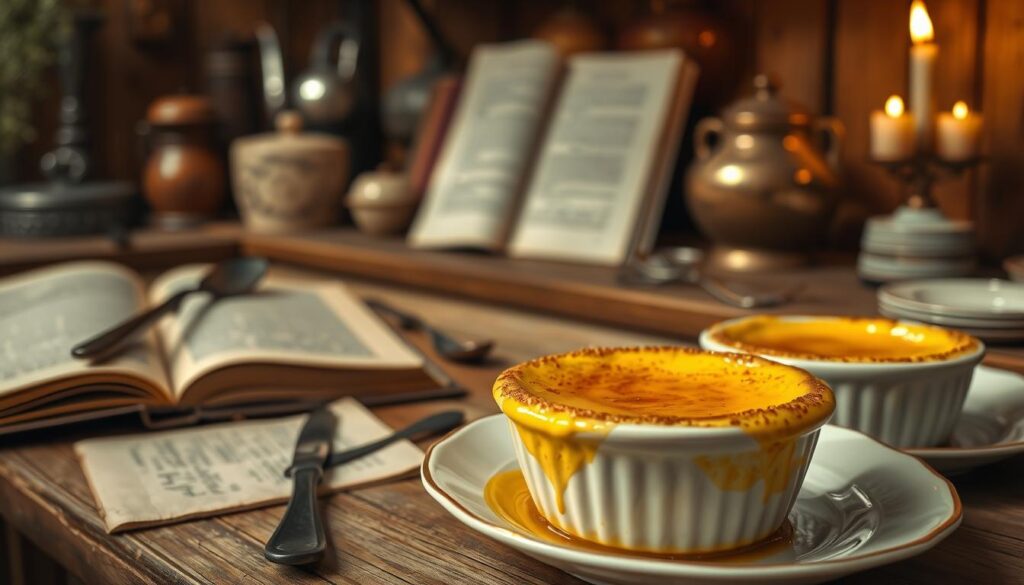Learning to make crème brûlée is all about mastering the art of caramelizing. This guide will show you the steps and secrets for a perfect crème brûlée. You’ll discover how to make a creamy custard topped with a crunchy caramel layer.
First, we’ll talk about the key ingredients and their roles. You’ll learn about the importance of dairy for the silky texture. We’ll also cover the right equipment, how to get that perfect caramel, and common mistakes to avoid. Get ready to wow your guests with a dessert that’s both sophisticated and expertly made.

Key Takeaways
- Understanding dairy fat content is crucial for the texture of your custard.
- Using a water bath ensures even cooking and prevents custards from curdling.
- Choosing the right sugar affects the ease of caramelization.
- Only using egg yolks can enhance creaminess and color in your dessert.
- The first printed crème brûlée recipe dates back to the 17th century.
- Jacques Pépin’s method balances whole milk and heavy cream for optimal results.
Understanding Crème Brûlée
Crème brûlée is a famous French dessert known for its rich flavors and textures. It has its roots in the 17th century, found in “Cuisinier Royal et Bourgeois” by François Massialot. This dessert is made with egg yolks, cream, and sugar, baked until smooth.
The history of crème brûlée shows how it has changed over time. It’s famous for its crunchy caramel top. When making it, knowing the ingredients is key. The cream and egg yolks give it a creamy richness.
When making crème brûlée, using the right amounts is important. A good rule is 1 egg yolk for every 1/2 cup of cream, plus 1 1/2 teaspoons of sugar. Adding a bit of cornstarch helps it stay smooth. Letting the cream infuse flavors for half an hour is also crucial.

Making crème brûlée needs careful attention. The custard cooks for 15 to 20 minutes, until it’s 170°F. Let it cool before chilling for at least 4 hours. This makes the custard perfect for the caramel topping.
Exploring crème brûlée reveals it’s more than just a dessert. It’s a celebration of taste, texture, and tradition.
Ingredients for the Perfect Custard
The right ingredients are key to a great crème brûlée. Choosing the right dairy and egg yolks makes your custard top-notch. Heavy cream and whole milk mix for a rich, indulgent taste.
The Role of Dairy
Dairy types are crucial for custard stability. Mixing heavy cream and whole milk gives a luxurious feel. High-fat content adds flavor and keeps it smooth.
Professional chefs often use heavy cream for an extra creamy texture. Others mix cream and milk for a balanced taste. Quality dairy makes the custard silky and rich.
Importance of Egg Yolks
Egg yolks are essential for a perfect crème brûlée. They add richness and prevent graininess. Start by whisking egg yolks with sugar until smooth.
Tempering egg yolks with hot cream is key to avoiding curdling. This keeps the custard smooth and creamy. Mastering egg yolk handling ensures a custard that’s both wobbly and melts in your mouth.

| Ingredient | Type | Role in Custard |
|---|---|---|
| Heavy Cream | Dairy | Adds richness and creaminess |
| Whole Milk | Dairy | Balances fat content and texture |
| Egg Yolks | Protein | Provides richness and acts as a thickener |
| Sugar | Sweetener | Enhances flavor and caramelizes for topping |
| Vanilla Bean | Flavoring | Infuses flavor into the custard |
Choosing the Right Equipment
Getting the right equipment is key to caramelizing crème brûlée well. There are many kitchen tools for dessert out there. A culinary torch is a must-have for even caramelization over the custard base.
Essential Tools for Caramelization
Choosing the right tools is crucial for perfecting your crème brûlée. Here are some must-haves for caramelizing:
- Culinary Torch: Great for creating a caramel crust. It heats sugar high enough to melt it.
- Ramekins: These dishes help cook evenly. They ensure your dessert cooks right and tastes great.
- Thermometer: It checks if your custard is at the perfect temperature. This makes it smooth and set right.
- Fine Mesh Sieve: Strains the custard mixture. This keeps it smooth and free of lumps.
Alternative Methods Without a Torch
If you don’t have a culinary torch, don’t worry. There are other ways to get great caramelization. Here are a few:
- Broiler Method: Place your ramekins under the broiler. Watch them closely to get caramelization just right without burning.
- Caramel Pour Method: Make caramel on the stovetop. Then, pour it over your chilled custard. This makes a beautiful topping without a torch.
These alternative caramelization techniques can give you crunchy, tasty results. They make sure you can enjoy a delicious crème brûlée, even without a torch.
How to Caramelize Brulee?
Learning to caramelize is key for a great crème brûlée finish. Using a culinary torch lets you control sugar melting. This way, you get a perfect golden crust without burning the custard. It’s a favorite among both home cooks and chefs.
Using a Culinary Torch for Even Caramelization
Start by dusting fine granulated sugar over your custard. This sugar turns into a tasty topping when heated. Here’s how to do it:
- Evenly sprinkle a thin layer of fine granulated sugar over the chilled custard.
- Hold the culinary torch about 2 inches above the sugar.
- Slowly move the flame back and forth until the sugar starts to melt.
- Continue until the sugar achieves a vibrant golden color, forming a crunchy crust.
It’s important to watch closely to avoid burning. Timing is key for a perfect golden crust. A careful approach ensures an even finish.
Using these caramelization techniques turns your dessert into a masterpiece. With practice, you’ll get glossy, even caramelization every time.
The Science Behind the Custard
Crème brûlée’s success depends on understanding its science. Key factors include baking temperatures and oven control. These elements help prevent egg proteins from scrambling, creating a smooth custard.
Temperature Control in Baking
Cooking crème brûlée at 205°F is key for a perfect dessert. This temperature ensures a slow, even baking process. It prevents scalding the egg mixture.
Using a water bath helps even more. It keeps the temperature steady, ensuring the custard cooks evenly.
Understanding Thickening and Coagulation
The custard’s thickness comes from egg protein coagulation. Whisking egg yolks with sugar and cream creates a special mix. This mix changes when heated, making the custard smooth and creamy.
Knowing this process helps avoid overcooking. It ensures your crème brûlée is velvety and delicious.
Techniques for Perfect Caramelization
Getting that perfect caramelized crust on crème brûlée might seem hard. But, the right techniques make it easy. Try the water bath method or broiling.
Using a Water Bath for the Best Results
The water bath technique, also known as the bain-marie method, is key for even cooking. It keeps your ramekins in a pan of hot water. This gentle heat prevents the custard from curdling or overcooking.
It makes the dessert silky smooth. Preheat your oven for the best baking results.
Broiling Method for the Crème Brûlée
Want a caramelized crust without a blowtorch? Try broiling. Chill your custards first, then broil them for quick caramelization. This method is fast but requires watching closely to avoid burning.
Broiling gives a great crust and uses common kitchen tools. It’s a quick and effective way to caramelize sugar.
Hidden Secrets from Professional Chefs
Making the perfect crème brûlée is all about mastering certain techniques. Professional chefs know that egg yolk preparation and using real vanilla are key. These steps are crucial for a rich, smooth custard that tastes amazing.
Whipping Egg Yolks to Perfection
Emulsification starts with egg yolk preparation. Whisking them until they’re pale and form a ribbon adds air. This makes the custard silky and gives it a great texture.
This texture is what makes your crème brûlée stand out. It’s smooth and delightful, unlike other desserts.
The Importance of Vanilla Flavoring
Vanilla beans are the best for adding flavor to desserts. They give a floral aroma and depth that vanilla extracts can’t match. Using high-quality vanilla makes your crème brûlée exceptional.
Professional chefs stress the importance of using real ingredients. This ensures your dessert has the right balance of flavors. It’s a secret to making your crème brûlée unforgettable.
Common Mistakes to Avoid
Making the perfect crème brûlée needs careful attention. Knowing common mistakes can improve your dessert skills. Two big issues happen during custard making and caramelizing.
Overcooking the Custard
Overcooking the custard can make it grainy, ruining the smooth texture. To avoid this, cook it right. Bake at 325°F (160°C) for 30-40 minutes. This way, the edges set while the center stays a bit jiggly.
Checking the temperature helps prevent curdling. This keeps your custard perfect.
Mistakes in Caramelization Techniques
Many struggle with caramelizing the sugar topping. Too much sugar or uneven heat can mess it up. Use superfine sugar for even melting under the torch.
Keep your hand steady while torching. This will make your dessert beautifully caramelized.
| Mistake | Solution |
|---|---|
| Custard Overcooking | Monitor baking time strictly, using a thermometer to check temperatures. |
| Using Whole Eggs | Stick to using egg yolks for a creamy texture. |
| Improper Caramelization | Utilize superfine sugar and ensure even heat distribution. |
| Too Much Sugar | Follow recipe measurements for optimal results. |
Conclusion
Mastering crème brûlée is an art that requires the right mix of ingredients, techniques, and care. You now have the tools to start making this delicious dessert. You can use a culinary blow torch, broiling, or the caramel pour method to perfect the caramel.
Creating a perfect crème brûlée means adjusting recipes and sizes to fit your needs. This guide offers a Vanilla Crème Brûlée for Two, but you can easily make it for four. Remember to follow the chilling and cooking times, and measure your ingredients carefully. These steps are key to getting a smooth custard and a caramelized top.
Use the dessert tips from this article to improve your skills. From baking at the right temperature to perfecting caramelization, each step is important. With practice, your crème brûlée will be as good as those in top restaurants. It will leave a memorable taste in everyone’s mouth.
FAQ
What is the best dairy to use for crème brûlée?
For a rich crème brûlée, mix heavy cream and whole milk. Some chefs choose heavy cream alone for extra luxury.
How can I achieve a perfectly caramelized sugar topping?
Use a culinary torch for even caramelization. Sprinkle sugar on the custard and torch it until golden. Watch closely to avoid burning.
Can I make crème brûlée without a culinary torch?
Yes, use the broiler method. Place the custard under the broiler for short times. Watch closely to prevent burning.
Why is the ribbon stage important when whisking egg yolks?
Whisking to a pale, ribbon-like consistency adds air. This helps create a smooth custard texture.
What are common mistakes to avoid when making crème brûlée?
Avoid overcooking, which makes the custard grainy. Also, don’t burn or unevenly caramelize the sugar.
What role does vanilla play in crème brûlée?
Vanilla, from real beans, boosts the flavor. It adds a delicate taste that extract alone can’t match.
How does temperature affect the baking of crème brûlée?
Bake at a low temperature, around 205°F. This cooks the custard gently, keeping it smooth.
What is the water bath technique, and why is it important?
A water bath, or bain-marie, is key for even baking. It cooks the custard gently, avoiding overcooking or curdling.

